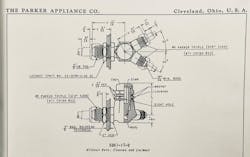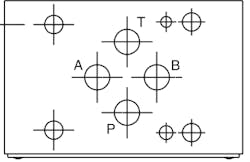Advances in control valves: How innovations are pushing the limits of performance
When the Titanic was launched on May 31, 1911, from Belfast, Ireland, the largest man-made object of its time was released down the slipway by pulling the hydraulic triggers, taking only 62 seconds to put the massive ship fully into the water in front of a cheering crowd of 100,000+. It may be hard to imagine various components, including hydraulic directional valves and hydraulic pumps, being used well over 100 years ago. The concepts of industrial hydraulics are pictured by most as being fairly modern, but designs and utilization of fluid power date back centuries.
The evolution of hydraulic directional control valves
In hydraulics, directional control valves are used to either change flow direction or simply start or stop the flow. Often referred to as “bang-bang” valves or “on/off” valves, which functionally means the valve is either completely open or completely closed, these valves are one of the most fundamental components of any fluid power system.
Early examples of directional valves were in-line two and three-position valves, primarily used for starting and stopping flow. As an example, below is an Art Parker-designed valve from 1940 made in Cleveland, Ohio, which is a three-port, two-position valve used for hydraulic breaking shut off, designed for the Army Air Corps during World War II.
As innovation and manufacturing capabilities significantly improved, designers moved away from lever and pilot actuation, making way for solenoid actuated valves that were introduced in the 1950s and 1960s. These early valves were still of the in-line orientation and design.
It was not until the 1970s that hydraulic manifolds began being manufactured. Today, this style is the most commonly manufactured hydraulic directional control valve. A typical example is a four-way, three-position spool, solenoid-actuated, with a mounting pattern of a standard industrial manifold pattern, such as an NFPA D03, pictured here in Figure 1.
As with any industrial product, design improvements became common among different manufacturers. Here are a few of the more notable examples:
Soft shifting to avoid hydraulic shock
Hydraulic shock is a phenomenon common in many high-pressure systems. It is caused by fast, temporary pressure spike due to the momentum that incompressible hydraulic oil has when it starts or stops moving rapidly. For example, a large-bore cylinder decompressing too quickly can cause the hydraulic oil to push into the hydraulic reservoir at a rapid pace, generating a pressure spike.
One option available to counter hydraulic shock is soft shifting through the directional control valves. Simply put, soft shifting increases the amount of time it takes to shift a hydraulic valve spool, thereby providing better control of the moving fluid over a short period of time while shifting the spool. This is one example of hydraulic dampening. Soft sifting, which is achieved by machining tighter orifices, typically reduces the spool shift by 20 ms – 800 ms.
Transient voltage suppressor (TVS) diodes reduce damage from voltage surge
An uncontrolled voltage surge is one of the most common ways solenoids on a directional control valve can be damaged. Surge suppression technology, made possible by a Transient Voltage Suppressor (TVS) diode, is often used for protection against this condition. TVS diodes can be bidirectional to add further protection.
Newer elastomers overcome performance restrictions
As is the case with many standard hydraulic components, the most common elastomers used in directional control valves are nitrile (buna-N) and fluorocarbon (Viton). Elastomers often dictate operational environment temperature thresholds. Typically, temperature ranges for nitrile tend to be -40°F to +250°F and for fluorocarbon -15°F to +400°F.
In frigid industrial environments, such as those in Siberia or the North Slope of Alaska, temperatures dip below what a standard valve using nitrile or fluorocarbon seals permits. Innovation in synthetic polymers has come a long way in being able to produce elastomers that can not only withstand temperatures as low as – 65° F, but also can maintain reliable performance over many years. Often these materials are proprietary or patented.
Phosphate ester fluids, known as aggressive hydraulics oils, are used primarily in aerospace and steam turbine applications. These fluids are the most fire resistant of the synthetic basestocks. Two elastomers that are chemically compatible with most phosphate esters are ethylene propylene (EPR) and ethylene propylene diene monomer (EPDM).
Other modern innovations of note
Manufacturers continue to introduce innovations that extend the capabilities and improve the performance of control valves. Some of the more recent, noteworthy innovations include:
- Lighter, slimmed-down valve bodies (especially in mobile applications where weight and space matter most)
- Zinc-Nickel plating for improved corrosion protection
- Spool positioning control for position feedback
- Unique serial number identification and data linkage through 2D barcodes
Directional control valves for challenging environments
Directional control valves in highly regulated environments must adhere to regulations tied specifically to where the valve is located during operation. Common certification agencies include:
- IECEx (Global)
- UL (Global)
- CSA (Canada and Global)
- ATEX (European Union)
- UKEX (United Kingdom)
- TR CU (EAC) (Russia and surrounding countries)
Valves designed to achieve multiple certifications at various levels of definition are becoming increasingly common. For example, a directional control valve may be considered “tri-rated” if it carries certifications in accordance with CSA, ATEX, and IECEx. Operating in highly regulated hazardous environments is often expensive and complex, so valves achieving multiple levels of certifications for a given part tend to be considered the most versatile.
Hazardous environment valves are typically bulky due to their design requirements such as needing to be held in fixed positions. One notable design innovation is Parker’s D1VW*ER patent-pending indexable solenoid cover which allows for multiple adjustable wiring installations while still maintaining an explosion-proof tri-rated certification. Oil and gas industry experts have been asking for complexity reduction. This design reduces the need for multiple explosion-proof fittings, while allowing for the same valve to be used across multiple installations.
Future challenges
Hydraulics are becoming more digital, surrounded by products that are smarter; even the “bang-bang” valves will not get left behind. Larger critical industrial systems and mobile equipment have increasingly seen cheaper sensors being embedded. Entire electrohydraulic systems are being “lit up” and data on efficiency, performance, temperature, flow and contamination are all now possible.
In the world of the Industrial Internet of Things (IIoT), embedded sensors can proactively capture, analyze and report data on such issues as a decline in the valve’s response time or a spool not shifting fully over time. Having this information could then alert an operator before a machine or equipment fails, helping increase safety or suggesting proactive replacement or repair before the feared “line-down” situation would occur. As more advanced technology is introduced over the next few years it will be more common for hydraulic systems to utilize directional control valves that have built-in diagnostic sensors to keep track of operating variables to further enhance the operational efficiencies of equipment.
From the launching of the Titanic to innovations in explosion-proof valves to the rise of IIoT, it is exciting to consider what the upcoming decades may offer in the way of innovation. It is probably safe to say that hydraulics and hydraulic valves will continue to get smarter as combined technologies continue to intermingle.
Mike Giammo is a product manager for Parker Hannifin's Hydraulic Valve Division.





